Chemical Hazard Control Strategies
Hazardous materials can be used safely in workplaces if adequate control strategies are used to prevent exposure to those chemicals.
A control strategy includes any device, procedure, piece of equipment, system, etc., that is used to keep hazardous chemicals from contacting workers at harmful levels.
To eliminate or reduce exposure to hazardous chemicals, an effective protocol called the "Hierarchy of Controls" has been developed.
When you determine during a workplace assessment that exposure to harmful levels of hazardous chemicals is present, try to eliminate or reduce that exposure using the following strategies in the following order:
The first three strategies focus on doing something with the hazard.
- Elimination: The best solution is to completely eliminate the need to use hazardous chemicals or substances.
- Substitution: Substitution is the next-best solution. Replace a toxic substance with a less-toxic substance. If you can't get rid of the toxic substances, you may be able to replace them with substances that are at least less toxic. The goal is to reduce the toxicity of the hazards to levels that do not require the use of administrative controls or personal protective equipment.
- Engineering Controls: Redesign processes that use toxic chemicals to eliminate or reduce exposure to the chemical hazard itself. This strategy seeks to control the hazard at the source by using such methods as total enclosure. It also attempts to control the hazardous chemicals along the path by using such measures as ventilation.
The last two strategies focus on doing something with behaviors to reduce exposure to the hazard.
- Administrative Controls: Change work procedures to reduce the duration, frequency, and severity of exposure to the chemical hazard. The chemical hazard, itself, is not eliminated or reduced using this strategy, only exposure to the chemical hazard. The primary focus is to incorporate safer work practices through written safety policies, rules, supervision and training. And that's a problem because you may have to regularly supervise employees as they perform a task. These controls work only so long as employees "behave" properly.
- Personal Protective Equipment (PPE): The use of PPE is probably the most common strategy, and in many cases, is a mandatory requirement when working with hazardous chemicals. The worker uses protective equipment to set up a barrier between worker and hazard. Once again, the chemical hazard is neither eliminated nor reduced, and a high reliance is placed on appropriate use of PPE for this strategy to be successful.
Remember, the first question you want to ask is, "How can I eliminate, reduce, or engineer out the hazard?" Hopefully you'll be able to eliminate the hazard or reduce it to the point where safe behaviors or PPE won't be necessary.
Knowledge Check Choose the best answer for the question.
2-8. Which control strategy focuses on worker behaviors?
You forgot to answer the question!

